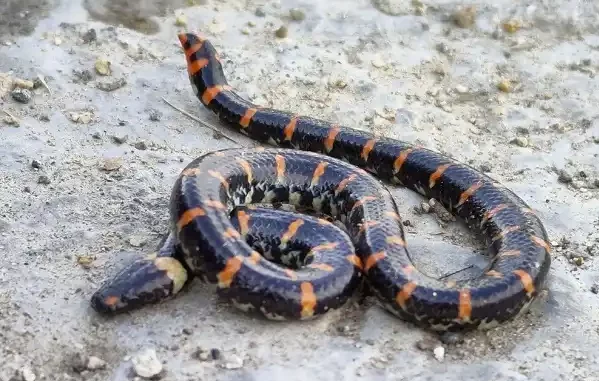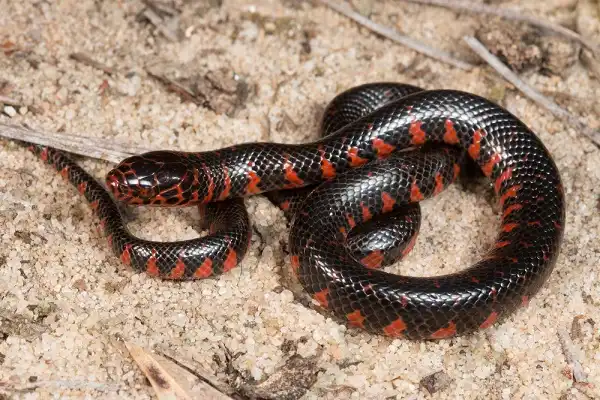If you look down into the muddy waters of swamps, wetlands, and marshes, you may get a glimpse of one of nature’s most elusive creatures – the mud snake. With its long, slender body and a broad head featuring striking black and yellow markings, this species of water snake is incredibly well-adapted to both aquatic and terrestrial environments. Whether it’s swimming through shallow rivers or crawling across the land in search of food, the mud snake lives an interesting life that many people don’t know about due to its secretive nature. Read on for more information about these unique snakes!

Mud Snake Description
Mud snakes are olive-brown or gray in color with black and yellow stripes running down their backs. These stripes sometimes form a checkered pattern along the snake’s body, and they usually have round eyes that are usually yellow or orange in color. The mud snake’s head is wider than its body, and it has a flat top that is used for digging. The mud snake has several adaptations that help it survive in its environment. Its nose is filled with sensory receptors that allow it to detect prey even when it’s submerged underwater, while its tail acts as an anchor when the mud snake needs to stay put against strong currents. Its body is slim and streamlined, which makes it an excellent swimmer.
Mud Snake Habitat
Mud snakes are mostly found in freshwater habitats, such as swamps, wetlands, marshes, small ponds, and lakes. They prefer shallow bodies of water with plenty of vegetation and mud bottoms, as they use these muddy environments to hide from predators and ambush their prey. In some areas, they may also be found in brackish or coastal waters near estuaries. Mud snakes can tolerate a wide range of temperatures and have been observed living at elevations up to 8500 ft (2590 m). During the winter months, they will often hibernate beneath the surface of the water or bury themselves in the mud at the bottom for protection against freezing temperatures. They are active during both day and night but tend to be more diurnal during warmer months.
Mud Snake Diet
The diet of the mud snake consists mainly of fish, amphibians, small reptiles and insects. They are opportunistic feeders and will take whatever prey is most readily available in their environment. Some of their preferred meals include frogs, crayfish, salamanders, turtles, and even small snakes. While they seem to prefer live prey over carrion (dead animals), they have been known to occasionally scavenge for food if necessary. When hunting for food, the mud snake will often lie motionless in the water or mud with just its head above the surface, waiting for unsuspecting prey to come close enough for it to strike. When striking out at its target, it will make use of a specialized jaw structure which allows it to capture larger prey than its own size would normally allow. It also uses chemical cues in the water to help detect potential food sources. In addition to preying on other animals, the mud snake also has a taste for plant matter such as fruits and berries that may be found growing near its aquatic habitat. This nutritional variety helps ensure that the snake stays healthy and provides them with essential nutrients such as calcium that are not always found in its animal-based diet.

Mud Snake Size
The mud snake is a quite small species of water snake that typically ranges in size from 24-60 inches (61-152 cm) in length. On average, most adult snakes measure around 40 inches (101 cm). Females are usually larger than males, with some females reaching lengths as long as 80 inches (203 cm). The head of the mud snake is relatively large and broad, while its tail is short and thin. Its scales are smooth and shiny, which helps it move swiftly through the water with ease. The mud snake has adapted to living in aquatic environments by having an elongated body that allows it to swim efficiently through the water. In addition to its unique body shape and coloration, the mud snake also has a specialized jaw structure which gives it an advantage when capturing prey. This adaptation enables them to catch creatures larger than themselves and hold onto them until they can swallow them whole. It also uses chemical cues present in its aquatic habitat to help locate prey and detect potential threats from predators.
Mud Snake Lifespan
Mud snakes have an average lifespan of 10-15 years in the wild, although some can live up to 20 years. They reach sexual maturity at around 4 years of age, and females will lay between 3 and 8 eggs per clutch. The eggs take around 3 months to hatch, after which the young snakes are independent and on their own. Mud snakes are relatively long-lived animals with a life expectancy greater than that of many other species of water snakes. They are also fairly hardy creatures and can survive in a variety of climates as long as they have access to enough food and suitable protection from predators. This allows them to survive in areas where other species may not be able to thrive. The primary threats to the mud snake’s lifespan come from predation by larger animals such as fish, turtles, birds, or mammals. In addition to predation, habitat destruction is another major threat for mud snakes, as wetlands are often drained or filled for development or agricultural use, which leaves the snakes without suitable habitats for shelter or food.
Mud Snake Behavior
Mud Snake Behavior is mainly determined by its environment and what drives it to survive. It is a diurnal species, meaning that it is active during the day, primarily searching for food or shelter. During the night, it takes refuge in burrows or crevices where it can rest undisturbed until morning. When hunting, they use their keen eyesight and chemical cues in the water to locate prey. Once they have detected a potential target, they will lunge out with their specialized jaw structure and capture it in order to feed. Mud snakes are also known to be quite social animals and often form large groupings when conditions are favorable. These groups typically consist of multiple males and females who will gather together in a specific area where there is plenty of food available, such as aquatic vegetation or fish eggs. They may remain together in these sites for extended periods of time, even courting one another during this time before eventually dispersing back into smaller subgroups or pairs.

Mud Snake Speed
Mud snakes are incredibly fast and able to slither through the water at speeds of up to 9.8 km/h (6 mph). This impressive speed is thanks to their streamlined bodies that are designed for moving through the water with minimal resistance. Their long, muscular tails also provide more thrust and help them propel themselves forward even faster. These snakes have been known to reach depths of 3-4 m (10-13 ft) when swimming in search of food or shelter, which indicates just how agile and powerful they can be in the water. In addition to their impressive swimming abilities, mud snakes can also move swiftly over land. They typically have a slow and steady gait on solid ground that allows them to navigate around small objects or other obstacles quickly and easily. This usually involves large sweeping movements from side to side as they travel along, which helps them maintain their balance while navigating through dense vegetation or over rocky terrain. Overall, mud snakes are capable swimmers that can travel great distances in short amounts of time thanks to their powerful muscles and streamlined shape. They use this agility both in the water and on land as a way of escaping predators or getting the jump on unsuspecting prey and it’s clear why these animals are so successful in their aquatic habitats.
Mud Snake Hunting
Mud snakes are skilled hunters, using various strategies to ambush their prey. They primarily rely on their keen eyesight and chemical cues in the water to identify potential meals. Once a is detected, the snake will lunge out with its specialized jaw structure, capturing it quickly and efficiently. Mud snakes have also been known to employ a ‘sit-and-wait’ approach, remaining still and camouflaged in vegetation until prey swims by them. Other tactics involve swimming in circles around an area until the prey is found or using their tail as a lure to attract small fish. Mud snakes mostly feed on smaller aquatic animals such as fish eggs, tadpoles, salamander larvae, crayfish, and frogs. They can also consume insects or other invertebrates they find while searching through the water or vegetation. In some cases, the snakes may even feed on larger animals such as rodents or birds that wander too close to the water’s edge. These remarkable creatures have evolved over time to become efficient predators in aquatic habitats across much of North America. Their powerful muscles enable them to move swiftly through the water while their sharp senses detect potential prey from afar.

Conclusion
Mud snakes are fascinating creatures that have adapted perfectly to living in aquatic habitats. Their streamlined bodies allow them to move swiftly and powerfully through the water while their sharp senses detect potential prey from afar. In addition, mud snakes are also capable of quickly moving over land when necessary, using their large sweeping movements to navigate around small objects or other obstacles. Overall, these remarkable animals have evolved to become highly efficient predators in many ecosystems across North America. As long as suitable habitats remain intact, they will continue to thrive in our continent for many years to come. With their incredible swimming abilities and specialized hunting strategies, mud snakes remain a formidable presence in the world of reptiles for generations to come.
Frequently Asked Question


